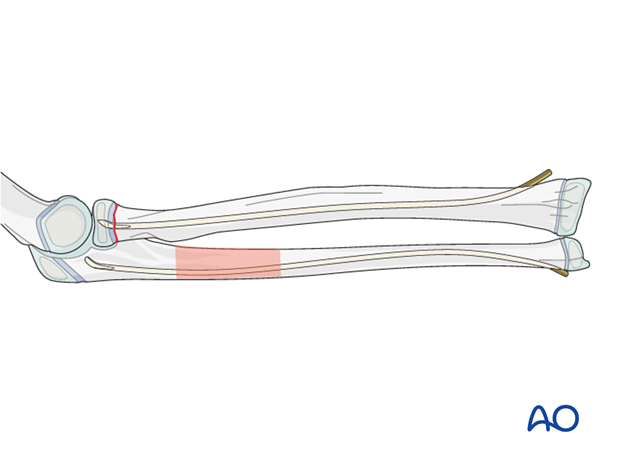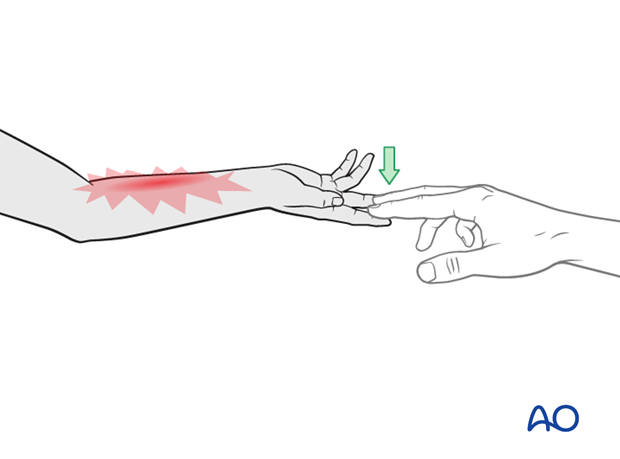ESIN
1. General considerations
Most of the ulnar fractures are in the proximal 1/3 so retrograde nailing of both bones is recommended.
The ESIN method involves closed reduction and internal fixation of both fractures with elastic nails or K-wires.
It can be used in any age group and any combination of fracture types.
Note: The risk of avascular necrosis of the radial head is higher after open reduction which should be avoided if possible.

2. Order of fixation
The ulna is treated first.
The radial neck fracture may spontaneously reduce after anatomical reduction and fixation of the ulna.
The radial neck fracture should also be fixed with an intramedullary nail to prevent redisplacement and to allow early joint mobilization.

3. Patient preparation
This procedure is normally performed with the patient in a supine position.

4. Reduction and fixation of the ulna
The steps for ulnar fracture fixation are described in the following ESIN procedure:

5. Reduction and fixation of radial head/neck
The steps required for proximal radial fracture fixation are described in the ESIN procedures for each fracture type:

6. Final assessment
Check the completed osteosynthesis with image intensification. These images should be retained for documentation or alternatively an x-ray should be obtained before discharge.
Make sure that the desired reduction has been achieved and the nails are of appropriate length.

7. Aftercare following ESIN
Immediate postoperative care
Whilst the child remains in bed, the forearm should be elevated on pillows to reduce swelling and pain.
They should be encouraged to use the arm.

Cast immobilization
Cast immobilization is not necessary and hinders early recovery of joint movement.
For Monteggia lesions treated with ulnar nailing, the forearm may be immobilized in a cast in the position of maximum stability of the radiocapitellar joint for 2-4 weeks.
Analgesia
Ibuprofen and paracetamol should be administered regularly during the first 4-5 days of injury, with additional oral narcotic medication for breakthrough pain.
If pain is increasing the child should be examined.
Neurovascular examination
The child should be examined regularly, to ensure finger range of motion is comfortable and adequate.
Neurological and vascular examination should also be performed.
Compartment syndrome should be considered in the presence of increasing pain, especially pain on passive stretching of muscles, decreasing range of active finger motion or deteriorating neurovascular signs, which are a late phenomenon.
See also the additional material on postoperative infection.

Compartment syndrome
Compartment syndrome is a possible early postoperative complication that may be difficult to diagnose in younger children.
The presence of full passive or active finger extension, without discomfort, excludes muscle compartment ischemia.
If there are signs of a compartment syndrome:
- If the child is in a cast, split the cast, along its full length down to skin level.
- Elevate the limb.
- Encourage active finger movement.
- Reexamine the child after 30 min.
If a definitive diagnosis of compartment syndrome is made, then a fasciotomy should be performed without delay.

Discharge care
Discharge from hospital follows local practice and is usually possible after 1-3 days.
The parent/carer should be taught how to assess the limb.
They should also be advised to return if there is increased pain or decreased range of finger movement.
It is important to provide parents with the following additional information:
- The warning signs of compartment syndrome, circulatory problems and neurological deterioration
- Hospital telephone number
- Information brochure
For the first few days, the elbow and forearm can be elevated on a pillow, until swelling decreases and comfort returns.
The arm can be placed in a sling for a few days until the patient is pain free. Many children are more comfortable without support.
Mobilization
Early movement of the forearm should be encouraged as soon as the patient is pain free.
Physiotherapy is normally not indicated.
Follow-up
The first clinical and radiological follow-up depends on the age of the child and is usually undertaken 4-6 weeks postoperatively.
At this point, the child should be able to move the forearm almost fully with some limited rotation caused by callus formation.
AP and lateral x-rays are required.
See also the additional material on healing times.
Nail removal
Nail removal is delayed until the fracture has modelled completely and can be performed as a day case, under general anesthesia.
The nail end in the proximal ulna can often be easily palpated.

In the distal radius and ulna, the nail end may slip under tendons and nerves. This may irritate the soft tissues and make it difficult to palpate the nail tip.
Exposure of the nail end should be performed under direct vision with small retractors.
In most cases, a small bursa has formed. Once this bursa is opened, the end of the nail can be seen.

The nail can be removed with the extraction pliers, or a similar clamp. A strong needle holder is also useful.














